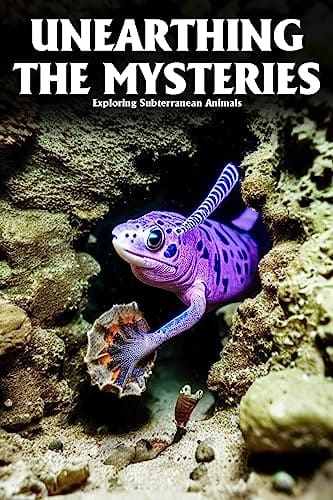Have you ever wondered about the secret lives of underground pests? In the hidden world beneath our feet, a diverse array of creatures thrive, causing havoc in our gardens and homes. From burrowing rodents to elusive termites, these pests can wreak havoc on our property and peace of mind. This article aims to shed light on the hidden world of underground pests, exploring their habits, dangers they pose, and effective pest control solutions to combat their nuisance. So, join us as we unearth the secrets of these elusive creatures and discover the best ways to keep them at bay.

1. Introduction to Underground Pests
1.1 Definition of Underground Pests
Underground pests refer to various organisms that thrive and cause damage beneath the surface of the ground. These pests include termites, rodents, moles, ants, beetles, worms, snakes, and grubs, among others. While their habitats may differ, they all share the common trait of residing and causing problems underground.
1.2 Importance of Understanding Underground Pests
Understanding underground pests is crucial for several reasons. Firstly, these pests can cause significant damage to structures, plants, and the environment as a whole. Having knowledge about their behavior and habits helps in identifying infestations early and implementing appropriate control measures. Secondly, these pests can pose health risks to humans and pets. Some underground pests, such as rodents and snakes, carry diseases that can be transmitted to humans and animals. Lastly, being aware of underground pests and their control methods allows homeowners and property managers to protect their investments and maintain a safe and healthy environment.
1.3 Common Types of Underground Pests
There are several types of underground pests that commonly cause problems. Some of the most prevalent ones include subterranean termites, rodents, moles, ants, beetles, worms, snakes, and grubs. Each of these pests has unique characteristics and behaviors that require specific control methods. It is essential to familiarize yourself with these pests to effectively identify and address infestations.
2. Subterranean Termites
2.1 Introduction to Subterranean Termites
Subterranean termites are highly destructive pests that primarily feed on wood and cellulose materials. They live in large colonies beneath the soil surface, building intricate tunnel systems to access their food sources. These pests are known for their ability to cause extensive damage to buildings and structures, often going unnoticed until significant harm has been done.
2.2 Identification and Behavior
Identifying subterranean termites can be challenging as they rarely emerge from their underground colonies. However, there are some signs to look out for, such as discarded wings, mud tubes along walls and foundations, hollow-sounding wood, and presence of termite swarmers. Subterranean termites are social insects, organized into castes including workers, soldiers, and reproductive individuals. They work tirelessly, constantly foraging for cellulose to support the colony.
2.3 Signs of Subterranean Termite Infestation
Being able to recognize the signs of subterranean termite infestation is crucial for early detection and prevention of extensive damage. Aside from the aforementioned mud tubes and discarded wings, other indicators include sagging floors, hollow-sounding wooden structures, and the presence of frass, which is termite excrement. It is important to regularly inspect your property and seek professional assistance if signs of termite activity are detected.
2.4 Damage Caused by Subterranean Termites
Subterranean termites have the potential to cause significant damage to homes and other wooden structures. They feed on cellulose-based materials, including wooden beams, flooring, furniture, and even books. The damage caused by these pests can compromise the structural integrity of buildings, leading to costly repairs or even collapse in severe cases. Additionally, termites can cause damage to trees and vegetation, impacting the overall health of landscapes.
2.5 Prevention and Control Measures for Subterranean Termites
Preventing and controlling subterranean termites requires a comprehensive approach. Firstly, it is essential to eliminate or minimize conditions that attract termites, such as excessive moisture and wood-to-soil contact. Regular inspections and timely repairs of any structural issues are also crucial. Additionally, professional pest control services can provide preventative treatments, such as soil treatments and bait systems, to help protect your property from termite infestations.

3. Rodents
3.1 Introduction to Rodents
Rodents are a common group of underground pests that include rats and mice. These pests are known for their ability to adapt to a wide range of environments and reproduce rapidly, making them a significant nuisance and health concern for humans. They can cause property damage, contaminate food, and transmit diseases through their urine, droppings, and parasites.
3.2 Common Rodent Species Found Underground
The most common species of rodents found underground are rats and mice. Rats, such as the Norway rat and the roof rat, often seek shelter in burrows and crawl spaces beneath buildings. They can gain access through small openings and can cause damage to structures, wires, and insulation. Mice, including the house mouse and the field mouse, also find refuge underground and are known for their ability to quickly infest homes and buildings.
3.3 Behavior and Damage
Rodents are nocturnal creatures that use their powerful teeth to chew through various materials, including wood, wires, and even pipes. Their gnawing behavior can lead to property damage, fire hazards, and water leaks. Additionally, rodents contaminate food and surfaces with their urine, droppings, and hair, posing a health risk to humans. Their presence can also trigger allergies and asthma in sensitive individuals.
3.4 Indications of Rodent Infestation
Detecting a rodent infestation early is crucial in preventing the rapid reproduction and spread of these pests. Common signs of rodent activity include gnaw marks on surfaces, droppings, footprints, and noises such as scratching or scurrying sounds. You may also notice damage to food packaging and insulation, as well as an unpleasant odor caused by their urine and droppings.
3.5 Preventive Measures and Control Options for Rodents
Preventing rodent infestations requires blocking their entry points and removing food and water sources. Seal up any cracks or gaps in foundations, walls, and roofs to prevent rodent access. Keep your living spaces clean, and store food in sealed containers. Traps and bait stations can be used for control, but for severe infestations, it is often best to seek professional pest control assistance. They have the knowledge and experience to effectively address rodent problems and implement long-term prevention strategies.
4. Moles
4.1 Introduction to Moles
Moles are small mammals that spend the majority of their lives underground. They have adapted physical attributes, such as strong forelimbs and specialized digging claws, which allow them to create complex networks of tunnels beneath the surface. Moles primarily feed on earthworms and insects found in the soil and can have a significant impact on lawns and gardens.
4.2 Mole Species and Habits
There are various species of moles, with the most common being the Eastern mole and the star-nosed mole. Moles are solitary animals that establish territories underground, often tunneling extensive networks for foraging and nesting purposes. They create characteristic molehills or raised ridges on the surface, which can disrupt the aesthetics of lawns and gardens.
4.3 Identification of Mole Infestation
Identifying mole infestations is relatively straightforward due to the visible signs they leave behind. Molehills, which are mounds of earth pushed up from their underground tunnels, are the most distinct evidence of mole activity. Raised ridges or surface tunnels running across your yard are also indications of a mole infestation. These signs should prompt further action to prevent extensive damage.
4.4 The Impact of Moles on Landscapes
While moles play a role in soil aeration and nutrient distribution, their tunneling activities can cause damage to lawns, gardens, and agricultural fields. The raised tunnels can create uneven surfaces, making mowing and maintaining lawns more challenging. Additionally, molehills can smother and kill grass and other plants, leading to patchy and unsightly landscapes.
4.5 Controlling and Repelling Moles
Various methods can be employed to control and repel moles. Trapping is a common and effective technique that involves placing traps in active tunnels. Talpex traps, scissor traps, or mole-specific traps can be used to capture and remove moles from your property. Additionally, encouraging natural predators, such as cats or dogs, can help deter moles. It is important to note that mole repellents, such as castor oil-based products, may have limited effectiveness and should be utilized in conjunction with other control methods for optimal results.

5. Ants
5.1 Introduction to Ants
Ants are social insects that live in colonies and can be found in various habitats, including underground. There are numerous species of ants that nest and forage beneath the ground, each with different behaviors and nesting habits. They are attracted to food sources and can cause problems when they establish colonies near or within human dwellings.
5.2 Underground Ant Species
Common species of ants that nest underground include Argentine ants, odorous house ants, and pavement ants. Argentine ants, for example, build massive colonies, often interconnected through underground tunnels. These ants are known for their rapid foraging behavior and can become a nuisance if they establish colonies near homes or structures.
5.3 Underground Nests and Behavior
Ants typically create intricate networks of tunnels and chambers below the ground to house their colonies. They excavate soil and construct nests, often near food sources or in areas with favorable moisture conditions. Ant behavior varies depending on the species, but all ants function as a unified colony, with workers foraging for food, soldiers defending the colony, and the queen reproducing.
5.4 Harm Caused by Ant Infestations
While not all ant species cause direct damage to structures, they can still be a nuisance and cause problems in households. Ants can contaminate food and attract other pests, such as cockroaches, while searching for food sources. Certain species, like carpenter ants, can burrow into wood, potentially causing structural damage over time. Additionally, stinging ants, such as fire ants, can pose a significant health risk, especially to individuals with allergies or sensitivities.
5.5 Effective Ant Control Methods
Effective ant control methods often involve a combination of prevention, sanitation, and targeted treatments. Regularly inspecting your property for any signs of ant activity and sealing entry points can help deter ants from entering your home. Cleaning up spills, keeping surfaces free of crumbs, and storing food properly will also reduce the attraction for ants. For severe infestations, professional pest control services may be necessary to implement targeted treatments and establish long-term control strategies.
6. Beetles
6.1 Introduction to Underground Beetles
Beetles are a diverse group of insects that inhabit various ecosystems worldwide. While many beetle species live above ground, some spend significant portions of their lives underground. These underground beetles play essential roles in soil health, but certain species can also become pests and cause damage to plants and crops.
6.2 Common Underground Beetle Species
Several species of beetles have adapted to underground habitats. Some examples include the blister beetle, wireworms, and the Japanese beetle larvae. These beetles vary in size, appearance, and behavior. It is important to identify the specific beetle species when addressing infestations to determine the most effective control methods.
6.3 Damage and Signs of Beetle Infestation
Beetles, particularly their larvae, can cause damage to plant roots, bulbs, and tubers. Wireworms, for instance, are the larval stage of click beetles and commonly feed on underground plant parts. Some signs of beetle infestations include wilting or yellowing plants, chewed roots, and the presence of adult beetles or larvae in the soil. Proper identification is key to accurately determining the extent of the infestation.
6.4 Prevention and Control of Beetle Infestations
Preventing beetle infestations requires a multi-faceted approach that focuses on cultural practices and targeted treatments. Proper soil preparation, crop rotation, and use of resistant plant varieties can help reduce beetle populations. Biological control methods, such as introducing natural predators or using parasitic nematodes, can also be effective. For severe infestations, insecticides labeled for beetle control may be necessary, but it is important to follow label instructions and consider the environmental impact.

7. Worms
7.1 Introduction to Underground Worms
Worms play a crucial role in soil health and ecosystem functioning. They facilitate nutrient cycling, improve soil structure, and enhance water infiltration. While many worms occupy the top layers of soil, several species dwell underground, forming intricate networks of burrows and tunnels.
7.2 Role of Worms in Soil Health
Underground worms contribute to soil health by burrowing and mixing organic matter with mineral soil. This process, known as bioturbation, helps improve soil structure, aeration, and drainage. Worms also excrete nutrient-rich casts that enhance soil fertility. By enhancing soil health, worms play a vital role in supporting plant growth and maintaining healthy ecosystems.
7.3 Types of Worms Found Underground
There are various species of worms that inhabit underground environments. Earthworms, particularly those in the Lumbricus and Eisenia families, are commonly found underground and are essential contributors to soil health. These worms are known for their burrowing activities, which help create channels for root growth and enhance the overall quality of the soil.
7.4 Worm Infestation Indicators
While worms are generally beneficial to soil health, high populations of certain species, such as invasive earthworms in forests, can disrupt natural ecosystems. Indications of excessive worm populations include dense aggregations on the soil surface, alteration of soil structure, and changes in plant communities. These situations may require specific management approaches to restore ecological balance.
7.5 Promoting Healthy Worm Population
Maintaining a healthy worm population involves providing a suitable habitat and avoiding practices that harm these organisms. Promote the presence of worms by adding organic matter, such as compost, to the soil. Avoid excessive pesticide use, as certain chemical treatments can harm worms and disrupt soil ecosystems. Additionally, protect the soil from erosion by implementing erosion control measures, such as mulching and terracing.
8. Snakes
8.1 Introduction to Underground Snakes
Snakes are fascinating creatures that inhabit a variety of habitats, including underground environments. While not all snake species live or nest underground, certain species, such as garter snakes and rattlesnakes, may seek refuge in burrows, crevices, or underground tunnels. It is important to understand their behaviors and habits to coexist safely with these reptiles.
8.2 Common Underground Snake Species
Several snake species may use underground areas as shelter or for hibernation. Garter snakes, for example, are known to take cover in underground burrows during harsh weather conditions. Rattlesnakes, which are venomous, often use rodent burrows as their hideouts. Identifying the specific snake species is crucial for assessing the level of risk and implementing appropriate control measures.
8.3 Behavior and Habits of Underground Snakes
Underground snake behavior can vary depending on the species and environmental conditions. Some snakes, like garter snakes, are harmless and primarily seek shelter or lay eggs in underground tunnels. Others, such as rattlesnakes, may use burrows to escape extreme temperatures or retreat during their inactive periods. Understanding snake behavior helps in minimizing human-snake encounters and preventing potential conflicts.
8.4 Signs of Snake Infestation
Detecting snake infestations underground can be challenging due to their elusive nature. However, there are some signs to be aware of, such as shed snake skins, tracks, or snake droppings near openings or crevices. In areas where venomous snakes are prevalent, keep an eye out for warning signs like rattlesnake sounds or specific habitat characteristics like rocky outcrops that may attract snakes.
8.5 Snake Prevention and Removal Techniques
Preventing snake encounters and promoting snake-free areas can be achieved through habitat modification and preventative measures. Clearing tall grasses, removing debris and clutter, and sealing openings and cracks can deter snakes from entering your property. In cases where snake removal is necessary, it is recommendable to seek assistance from professional snake handlers or wildlife control experts. Attempting to handle snakes without proper knowledge and equipment can be dangerous.

9. Grubs
9.1 Introduction to Grubs
Grubs are the larval stage of various beetle species, including Japanese beetles, June bugs, and European chafer beetles. They typically reside in the soil, feeding on grassroots and organic matter. While some grubs play important roles in soil health, high populations can cause damage to lawns, golf courses, and agricultural fields.
9.2 Different Types of Grubs
There are several types of grubs found underground, each attributed to different beetle species. Japanese beetle larvae are one of the most notorious grubs known for their voracious appetite and damage to turfgrass roots. June bug grubs, also called white grubs, are common pests that can harm lawns. European chafer grubs are another destructive species that feed on grassroots and can cause significant damage to turf.
9.3 Damage Caused by Grub Infestation
Grub infestations can result in extensive damage to lawns and landscapes. The larvae feed on grassroots, weakening plants and causing them to wilt or die. Affected areas may show signs of uneven or discolored turf, easily lifted or detached sod, or increased activity by birds or skunks foraging for grubs. Identifying grub infestations early can prevent severe damage and aid in implementing control measures.
9.4 Identifying Grub Infestation
Detecting grub infestations requires digging into the soil and inspecting the roots of affected plants. Look for C-shaped white larvae with brown heads, often curled into a C-shape. Additionally, damaged turf that easily pulls up like a loose carpet or the presence of birds, skunks, or raccoons actively digging in your lawn can also indicate a grub problem.
9.5 Effective Control and Prevention Methods for Grubs
Combating and preventing grub infestations involves a combination of cultural practices and targeted treatments. Proper lawn maintenance, including regular watering, mowing at the right height, and overseeding, helps promote healthy turf and reduce vulnerability to grubs. In cases of severe grub damage, insecticides specifically labeled for grub control may be necessary. Timing is crucial, as treatments are most effective during specific periods of grub development. Consult with a professional or refer to local extension resources for specific recommendations.
10. Underground Pest Control Solutions
10.1 Importance of Professional Pest Control
When dealing with underground pests, professional pest control services offer expertise and specialized knowledge. They can assess the extent of infestations accurately and implement targeted control methods to address the specific pest issues. Pest control professionals are trained to handle pesticide applications safely and effectively, ensuring the health and safety of both humans and the environment.
10.2 DIY Pest Control Methods for Underground Pests
While professional assistance is often recommended for dealing with underground pests, there are some DIY methods you can try. For example, sealing cracks and gaps in structures prevents pest entry, while maintaining cleanliness and proper sanitation reduces attractants. Traps, baits, and natural repellents may also provide temporary relief for certain pests. However, it is important to understand the limitations of DIY methods and seek professional help for severe or persistent infestations.
10.3 Environmentally Friendly Pest Control Options
For those seeking environmentally friendly pest control options, several approaches can be employed. Integrated Pest Management (IPM) is a sustainable approach that incorporates multiple techniques to manage pests effectively while minimizing pesticide use. Physical barriers, biological control agents, pheromone traps, and cultural practices are all components of eco-friendly pest control. Consult with a pest control professional knowledgeable in eco-friendly methods to determine the best approach for your specific pest situation.
10.4 Integrated Pest Management Techniques
Integrated Pest Management (IPM) is a comprehensive approach to pest control that combines various techniques tailored to specific pests and environments. IPM focuses on prevention, monitoring, and uses the least toxic methods first before considering pesticide use. By incorporating cultural practices, biological control, physical barriers, and targeted treatments, IPM aims to minimize the impact on beneficial organisms and the environment while effectively managing pests.
10.5 Selecting the Right Pest Control Products and Services
Selecting the right pest control products and services is crucial for effective pest management. When choosing pesticides, opt for formulations specifically labeled and registered for the target pests. Follow label instructions and consider the potential environmental impact. It is often beneficial to consult with professional pest control services that can provide expert advice and guidance on selecting the most appropriate products and services for your specific pest control needs.
In conclusion, understanding the hidden world of underground pests is essential for maintaining a safe and healthy environment. From subterranean termites to rodents, moles, ants, beetles, worms, snakes, and grubs, each type of underground pest requires specific knowledge and control methods. By familiarizing yourself with their behavior, identifying signs of infestation, and implementing preventive and control measures, you can mitigate the damage caused by these pests and protect your property. Whether through professional pest control services or DIY methods, addressing underground pest issues promptly and effectively is the key to long-term pest management success.

I am Randy, the author behind PestControld.com. Drawing from decades of experience, I aim to provide valuable insights, expert advice, and practical recommendations to help you make informed decisions when assessing viable pest control solutions.